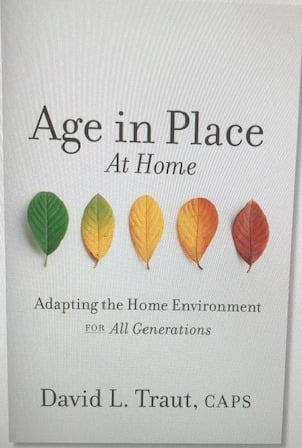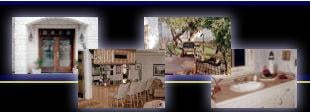
Have you, like others, discovered you need to adapt your current house and don’t know where to begin? If so, this book is your pathfinder. Or perhaps you have determined it’s best for you and your spouse to safely age at home surrounded by neighbors and familiar surroundings, but you need to identify how to proceed to Age in Place.
David L. Traut’s book, "Age in Place At Home", acts as a guidepost for exposing and modifying the shortcomings to accessibility your home exhibits. It will inspire and empower you to confront and overcome these problematic areas negatively affecting family members who need home accessibility the most.
What are some familial challenges most associated with Aging in Place home modifications?
- You have a growing special needs child.
- Elder family members are unable to maneuver through your present home's barriers.
- A family member has suffered an accident and needs better accessibility to recover.
- A family member suffers from a chronic degenerative disease.
- You have decided to move an aging parent into your home needing increased accessibility.
- Your extended family has undertaken a multi-generational path and lacks privacy and usability.
"Age in Place at Home" relinquishes your “just for now” attitude about establishing home. The book explains how you can eliminate accessibility problems: in a commonsense way while you avoid moving from house to house to accommodate the changing needs of your family. Many factors contribute to our interior design crisis like:
- You are intimidated by steep, unapproachable home entrances.
- Your home contains narrow doorways and entrances..
- You have bathrooms that are too small lacking room for maneuverability.
- Your home contains Impassible hallways due to a narrow width or ninety-degree turns.
- Your kitchen has become unusable due to a lack of adaptability.
Never fear. You can adapt almost any existing home environment to overcome difficulties and enable you and everyone else in the family to comfortably live at home and move around safely with correct planning and know-how.
Your quality of life will improve if you follow the book's advice. The positive result is every family member has equal accessibility throughout your home's interior. IT JUST MAKES GOOD SENSE.
Everyone planning to remain in their home to Age in Place is looking for safety, security, ease of use, and comfort in search of elder living solutions. They are looking for experienced and professional guidance. Homeowners and families must openly plan for future housing needs to overcome injuries, chronic illness, or the negative affects of aging. The current housing inventory does not offer the features needed for safety and accessibility in the numbers required to accommodate the growing demand. Savvy homeowners have weighed the costs of institutional living compared to their home’s expenses. They also realize the difference in adhering to stringent rules in a nursing facility instead of independently and freely residing in their present home.
Before and after retirement is an excellent time to prepare the house for what comes next in life—before any significant health issues appear. Choosing to Age in Place earlier in life using Universal Design techniques means a family can longer enjoy the home without obstruction. Their relatives, visitors, and children have peace of mind assured the aging loved ones or the chronically ill are safer living at home.
The truth is, with professional help, you can adapt almost any home environment to enable you and everyone else in the family to live within it to the fullest extent safely. The process is not age-related. Disability can strike any family member at any age. The need for greater home accessibility is the common thread. Universal Design or inclusive design is a design and building pathway that makes homes more accessible to all regardless of their age, mobility, or ability when appropriately used. The design process offers a seamless path for Aging in Place. It addresses the requirements of special needs families or multigenerational situations. Solutions for diverse living conditions are now becoming a possibility.
Regardless of size or ability, people are becoming more familiar with Universal Design and Aging in Place if considering a home remodeling project. Some people use these words interchangeably, but while they are similar, they do differ. Both are specific design techniques used in making a home more comfortable and accessible for individuals of different abilities. Universal Design deals more with customized new dwellings and a proactive remodeling approach for people wanting to Age in Place before any health issues arise. Aging in place design strictly involves remodeling existing homes to accommodate physical needs brought on by sudden health issues in a reactive manner. The costs for both processes represent a beneficial investment in your home for future needs as opposed to merely spending involving aesthetically pleasing remodeling projects.
I came to realize over my nearly 40 year building career that homes exhibiting cramped twisting hallways with narrow doorways, bathrooms lacking maneuvering space and usability, kitchens without accessible storage and workspaces, and stepped home entries represented commonly replicated home design flaws. The book points out how the home building industry has always lacked inclusion for all homeowners with their ever-changing needs.
As a Certified Aging in Place (CAPS) professional (#1636580) and an Aging in Place specialist, I am confident my book, which is now available through Amazon , introduces you to a new way of thinking about you and your home's future. It is a guide for solving diverse home needs for all people affected by varying physical conditions and aging. I decided to write this book due to many customer requests for a summation of suggestions to improve their home's accessibility, comfort, usefulness, and sustainability, along with ideas they could share with others. I based the information provided on countless past walkthroughs, home assessments, and my design/build remodeling projects. Inside, you can discover room by room the benefits of using the principles of Universal Design and how to incorporate them periodically throughout your living environment at your own pace. I take you through a home, making suggestions for what will increase your and your family's future accessibility in every room. You will notice the chapters involving the bathroom and kitchen are pretty extensive. They represent the most important rooms to consider when planning to Age in Place. The most utilized rooms in our homes must accommodate all diverse residents and visitors.
Do not allow your home to hold you or your loved ones captive within its walls and learn how to enable your home to conform to you and the needs of your family. Please think ahead positively and proactively while preparing your home for the future.
David L. Traut, CAPS










